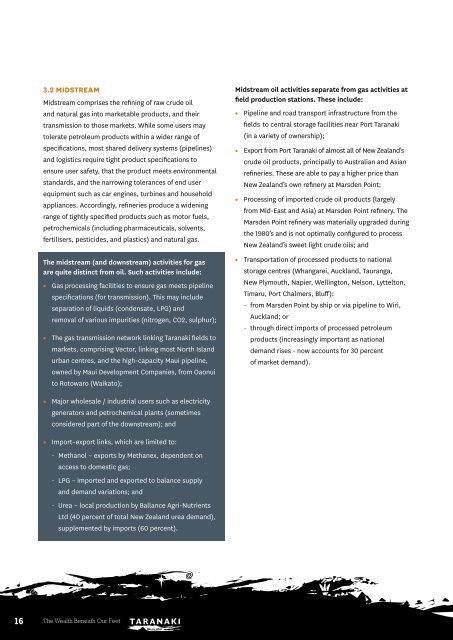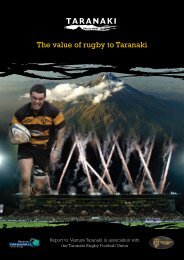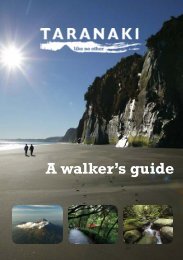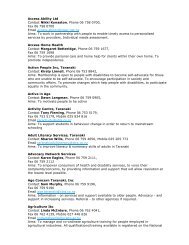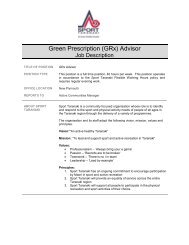The Wealth Beneath Our Feet - full report (6.4 MB ... - Venture Taranaki
The Wealth Beneath Our Feet - full report (6.4 MB ... - Venture Taranaki
The Wealth Beneath Our Feet - full report (6.4 MB ... - Venture Taranaki
You also want an ePaper? Increase the reach of your titles
YUMPU automatically turns print PDFs into web optimized ePapers that Google loves.
3.2 MidstreamMidstream comprises the refining of raw crude oiland natural gas into marketable products, and theirtransmission to those markets. While some users maytolerate petroleum products within a wider range ofspecifications, most shared delivery systems (pipelines)and logistics require tight product specifications toensure user safety, that the product meets environmentalstandards, and the narrowing tolerances of end userequipment such as car engines, turbines and householdappliances. Accordingly, refineries produce a wideningrange of tightly specified products such as motor fuels,petrochemicals (including pharmaceuticals, solvents,fertilisers, pesticides, and plastics) and natural gas.<strong>The</strong> midstream (and downstream) activities for gasare quite distinct from oil. Such activities include:••Gas processing facilities to ensure gas meets pipelinespecifications (for transmission). This may includeseparation of liquids (condensate, LPG) andremoval of various impurities (nitrogen, CO2, sulphur);••<strong>The</strong> gas transmission network linking <strong>Taranaki</strong> fields tomarkets, comprising Vector, linking most North Islandurban centres, and the high-capacity Maui pipeline,owned by Maui Development Companies, from Oaonuito Rotowaro (Waikato);Midstream oil activities separate from gas activities atfield production stations. <strong>The</strong>se include:••Pipeline and road transport infrastructure from thefields to central storage facilities near Port <strong>Taranaki</strong>(in a variety of ownership);••Export from Port <strong>Taranaki</strong> of almost all of New Zealand’scrude oil products, principally to Australian and Asianrefineries. <strong>The</strong>se are able to pay a higher price thanNew Zealand’s own refinery at Marsden Point;••Processing of imported crude oil products (largelyfrom Mid-East and Asia) at Marsden Point refinery. <strong>The</strong>Marsden Point refinery was materially upgraded duringthe 1980’s and is not optimally configured to processNew Zealand’s sweet light crude oils; and••Transportation of processed products to nationalstorage centres (Whangarei, Auckland, Tauranga,New Plymouth, Napier, Wellington, Nelson, Lyttelton,Timaru, Port Chalmers, Bluff):--from Marsden Point by ship or via pipeline to Wiri,Auckland; or--through direct imports of processed petroleumproducts (increasingly important as nationaldemand rises - now accounts for 30 percentof market demand).••Major wholesale / industrial users such as electricitygenerators and petrochemical plants (sometimesconsidered part of the downstream); and••Import–export links, which are limited to:--Methanol – exports by Methanex, dependent onaccess to domestic gas;--LPG – imported and exported to balance supplyand demand variations; and--Urea – local production by Ballance Agri-NutrientsLtd (40 percent of total New Zealand urea demand),supplemented by imports (60 percent).16<strong>The</strong> <strong>Wealth</strong> <strong>Beneath</strong> <strong>Our</strong> <strong>Feet</strong>


